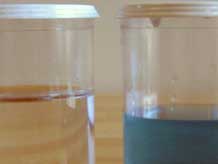How do oil and water compare?
1. Ask the question
Review with the class what we've learned about liquids so far in this unit. We know that liquids flow and take the shape of their containers. We know that we can measure their volume "by eye," or by using cubic centimeters, or with a measured cup. Point out that this is true for all liquids.
But are all liquids alike? Take mineral oil and water, for example. Would you use water to grease a pan? Would you use oil to put out a fire?
Share today’s investigation question:
How do oil and water compare?”
Begin a discussion of what students already know about the properties of oil and water:
- What are some properties of water that you have noticed?
- e.g., water is clear, "wet," "thin," and "splashy"
- What are some properties of oil that you have noticed?
- e.g., oil is "sticky," "slippery," "thick," and pours slowly

Remind students that they know something else about oil and water. Ask them to look back at the data they collected when they compared the volumes of 40 grams of water, oil, sand, and soil (Heavy for Size, Investigation 2.1, Observations of Weights and Volumes).
- How did the volumes of oil and water compare?
- the oil had a greater volume
- What if, instead of 40 grams of oil and water in the container, you had only 20 grams of each. Try to picture it. How would the volumes compare? Would there be a greater volume of oil or a greater volume of water? Or would they be the same?
- What if you had 80 grams each of oil and water? How do you predict the volumes would compare?
As students share their ideas, let them know they are about to find out if their predictions are correct.



